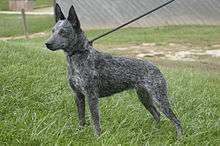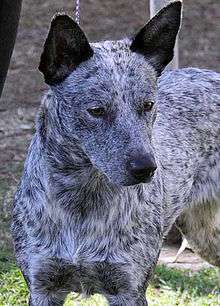Australian Stumpy Tail Cattle Dog
The Heeler is a naturally bobtailed or tailless, medium-sized cattle dog similar and/or related to the Australian Cattle Dog (aka, "Queensland Heeler"). The Australian Stumpy Tail Cattle Dog was developed in Australia[1] to herd cattle,[2] and descends from crosses between European herding dogs and the Australian dingo. The name is spelled both with hyphenation, Blue Heeler,[2] and without,[3] and the shorter name Heeler is also sometimes applied.[4]
| Australian Stumpy Tail Cattle Dog | |||||||||||||||||||||
|---|---|---|---|---|---|---|---|---|---|---|---|---|---|---|---|---|---|---|---|---|---|
 | |||||||||||||||||||||
| Other names | Stumpy Tail Cattle Dog | ||||||||||||||||||||
| Common nicknames | Stumpy, Stumpy Tail, Heeler | ||||||||||||||||||||
| Origin | Australia | ||||||||||||||||||||
| |||||||||||||||||||||
| |||||||||||||||||||||
| Dog (domestic dog) | |||||||||||||||||||||
History
The Heeler descended from Smithfield herding dogs of England, which were brought to Australia in the early 19th century and cross-bred with the dingo. Records of working dogs are scarce from this time period, and there are differing accounts of the breed's development. One is that a drover named Timmins from Bathurst, New South Wales, crossed the Smithfield dogs with dingoes, producing a type of working dog called Timmins' Biters.[1][5] In order to mute their dingo characteristics and make the dogs easier to handle, further crosses were made with Scottish Smooth Collies, producing speckled red and blue dogs that were often born tailless.
In the book A Dog Called Blue, author Noreen Clark makes the case that both the tailless Heeler and the Australian Cattle Dog (a.k.a. "Queensland Heeler") descended at one point from the same stock, called Halls Heelers, kept in the 1830s by a very large cattle operation run by Thomas Hall. The dogs were also crosses of Smithfield dogs and dingoes, but the breeds diverged at some point in the late 20th century. Selective breeding of the tailless or short-tailed dogs has fixed the characteristic of today's breed.[1][5]
Breed recognition
The Blue Heeler has been recognised as a standardised breed since 1988[3] in its native country by the Australian National Kennel Council, in its "Group 5 (Working dogs)".[3] It is also recognised by the nearby New Zealand Kennel Club in its "Working" group.[2]
More internationally, the breed was provisionally accepted by the Fédération Cynologique Internationale in 2005, as breed standard 351, in "Group 1, Section 2: Cattle Dogs (Except Swiss Cattle Dogs)".[1] As of 2010, it is also recognised as simply the Stumpy Tail Cattle Dog by the US United Kennel Club (in its "Herding Dog Breeds" group) since 1996,[4] and by the longer name in the Canadian Kennel Club (in its "Group VII: Herding Dogs"),[6] but not by the Kennel Club (UK), nor by the American Kennel Club.[7]
The breed may also be listed by minor kennel clubs, working or herding dog clubs, or Internet-based dog registry businesses, and promoted as a rare breed pet.

Appearance
The Heeler is a normally proportioned, rugged dog with pricked (standing up) ears and long legs. The breed's most distinctive feature, for which the breed is named, is the frequent lack of a tail. When there is a tail, it is quite short, no longer than 10 cm (4 in.), and undocked.[3] The coat is medium length to short, straight, dense and harsh. The coat color is a speckled red or speckled blue. Heelers do not show brown points or markings as seen on the ACD. Height is [7] 46–51 centimetres (18–20 in) at the withers for dogs, with females slightly smaller. Blue Heelers (a.k.a. "Queensland Heeler") (with a long tail) is similar in appearance to the Heeler, but the Australian Cattle Dog is proportionally heavier, less leggy and has brown points and markings.
Temperament
The ideal temperament of the Heeler is described in the breed standard as alert and watchful, as well as responsive to its owner and reserved around strangers, but also notes that "it must be amenable to handling" at shows.[3] All working dogs need early socialisation with people, and consistent training and activity throughout their lives.
Activities
Heelers can compete in dog agility trials, obedience, showmanship, flyball, tracking, frisbee and herding events. Herding instincts and trainability can be measured at noncompetitive herding tests. "Stumpies" exhibiting basic herding instincts can be trained to compete in herding trials.[8]
See also
- Anatomical terms of location
- Dog terminology
References
- "FCI-Standard No. 351: Australian Stump Tail Cattle Dog" (PDF). FCI.be. Fédération Cynologique Internationale. 13 July 2005. Retrieved 2 April 2016.
- "Australian Stumpy-Tail Cattle Dog: Working". NZKC.org.nz. New Zealand Kennel Club. 2016. Retrieved 2 April 2016.
- "Australian Stumpy Tail Cattle Dog". ANKC.org. Australian National Kennel Council. 2 July 2009. Retrieved 2 April 2016. PDF version Archived April 3, 2016, at the Wayback Machine also available.
- "Stumpy Tail Cattle Dog: Official UKC Breed Standard". Res.UKCDogs.com. United Kennel Club. 1 January 2008. Archived from the original on 17 April 2016. Retrieved 2 April 2016. PDF version also available.
- Rogers Clark, Anne; Brace, Andrew H. (1995). The International Encyclopedia of Dogs. Howell Book House. p. 453. ISBN 0-87605-624-9.
- "Official Breed Standards: Australian Stumpy Tail Cattle Dog". CKC.ca. Canadian Kennel Club. January 2007. Archived from the original on 2016-03-26. Retrieved 2 April 2016.
- "Stumpy Tail Cattle Dog: Breed Description & Information". Canada's Guide to Dogs. Dazzle by Design Graphics Studio. 16 October 2010. Retrieved 2 April 2016.
- Hartnagle-Taylor, Jeanne Joy; Taylor, Ty (2010). Stockdog Savvy. Alpine Publications. ISBN 978-1-57779-106-5.